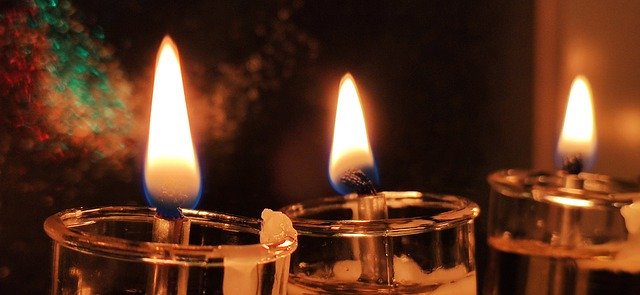The Shulchan Aruch succinctly tells us (673) that ‘all oils and all wicks are kosher to be used in the menorah and one fulfills their mitzvah with them.’ In fact, one fulfills his obligation by lighting any fuel, even the fats of non-kosher animals. However the commentaries on the Shulchan Aruch all indicate that it is preferable to use kosher substances. Oil of a combination of milk and meat, or of shmittah produce, would be forbidden to be used.
The Rema (ibid) tells us that the ideal fuel is olive oil, reminiscent of the oil used in the menorah in the Bais Hamikdash. He then adds that his custom is to use wax candles as their light is especially clear.
From the Rema it seems, and this is abundantly clear in his commentary on the Tur, that the advantage of a clear flame supersedes the advantage of being comparable to the oil in the Bais Hamikdash, and therefore when presented with the choice of wax candles versus olive oil one should choose the wax candles.
However, the opinion of the Kol Bo, which was adopted by most of the later poskim (among them the Levush, Chayei Adam and Mishna Berura), is that olive oil would be the most preferred option. Only if olive oil were not available would one defer to the standard of the clearest flame.
There is a third opinion, which is that of the Maharal, who indicates that any oil is preferable to a solid candle, as the miracle was performed with oil, a liquid, rather than a solid. This would be a somewhat logical inference; our olive oil would not be eligible for use in the Bais Hamikdash, and its use is only supposed to be reminiscent of the Bais Hamikdash. As such, the more reminiscent one’s menorah fuel is the better it would seem to be. However the Shaar Hatzion, quoting the Machtzis Hashekel, writes that our custom is not in accordance with the Maharal.
[For a deeper analysis of this dispute, beyond the scope of this article, see Dibros Moshe Shabbos 26:23].
If one does choose to use candles, either because he follows the Rema’s opinion, or for convenience or economic reasons, it is important to be aware that many of the commercially available candles do not last for the required 30 minutes, and it is important to purchase those that do.
If one uses olive oil, they will achieve the hidur of using oliveoil no matter what grade or type of oil they use, as long as it is 100% olive oil.
In recent years there has been a surge in available ‘pre-filled’ oil cups, where the user has only to remove a cap and immediately has a ready to use (and super mehadrin) glass full of olive oil with a wick correctly placed. This saves a lot of time and mess, and has become a very popular option. [Whether or not it is appropriate to out-source your mitzvah preparations is not our subject today, perhaps in a future article].
One twist on this innovation is to, via a chemical additive, ‘gel’ the olive oil, which makes the transportation and care substantially easier, and obviates the need for a cap or any sort of anti-spill design.
Would this gelled olive oil be included in the most preferred method of lighting according to the Kol Bo et al, who prefer olive oil in order to be comparable to the oil lit in the Bais Hamikdash?
According to the Maharal cited above it would seem certain that this is not a preferred method, as he is of the opinion that a liquid fuel will always be preferred over a solid one.
The opinion of Rav Nissim Karelitz is that we are striving for comparability to the candles lit in the Bais Hamikdash. Once it is not fully comparable the advantage of olive oil is lost. This opinion, for slightly different reasoning, is shared by Rav Moshe Shternbuch (Teshuvos VeHanhagos 3:218) and Rav Asher Weiss.
The Shevet Halevi discusses whether it would be permissible to use congealed oil in the Bais Hamikdash, and although he concludes that it would not, he states that a full analogy is not needed and gelled olive oil would have the advantage of olive oil discussed by the Kol Bo. As we pointed out, even clear, liquid olive oil would not be acceptable for use in the Bais Hamikdash, which indicates that a full equivalency is not required. This is also the opinion of Rav Elyashiv, Rav Shlomo Miller and Rav Shmuel Kamenetsky.
There is a remarkable comment written by the Teshuvah Meahavah (285) in which he states that the oil used in the Chanukah story was a congealed jug of olive oil! According to this all the opinions above, including the Maharal, would seemingly agree that the gelled oil is included in the most preferred way of lighting.


Why can’t you use a ‘milk and meat’ combo since the combo is not for food purposes , the same condition that applies to shampoo ?
The problem would be the cooking of milk and meat together, a prohibition unto itself.
R Eliyashev ztl writes since the coagulant is less than 1/60 it’s ok?
Is this a kosher issue (it doesn’t have to be)
Is the coagulant not a fuel? If so it is a Davar HaMymid so it’s not batul b shishim??? Any thoughts?